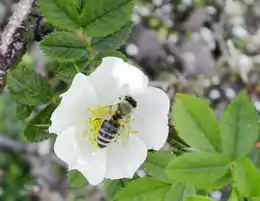Neoptera
Neoptera is a classification group that includes most orders of the winged insects, specifically those that can flex their wings over their abdomens. This is in contrast with the more basal orders of winged insects (the "Palaeoptera" assemblage), which are unable to flex their wings in this way.
| Neopterans | |
|---|---|
 | |
| Honeybee (order Hymenoptera) | |
| Scientific classification | |
| Kingdom: | Animalia |
| Phylum: | Arthropoda |
| Class: | Insecta |
| Branch: | Metapterygota |
| Infraclass: | Neoptera |
Classification
The taxon Neoptera was proposed by А.М. Martynov in 1923 and 1924, in the following classification:[1][2]
- division Palaeoptera
- order Odonata
- order Agnatha (correct name: Ephemeroptera)
- †order Dictyoneuridea
- †order Megasecoptera
- †order Protodonata
- †order Protephemeroidea
- division Neoptera
- subdivision Polyneoptera
- superorder Orthopteroidea (Anartioptera)
- order Orthoptera
- order Plecoptera
- order Dermaptera
- order Embioptera
- order Phasmatodea
- superorder Blattopteroidea (senior name: Pandictyoptera)
- superorder Orthopteroidea (Anartioptera)
- subdivision Paraneoptera
- order Hemiptera (correct name: Arthroidignatha)
- suborder Phytophtires (correct name: Plantisuga)
- suborder Auchenorrhyncha
- suborder Heteroptera
- subdivision Oligoneoptera
- order Hemiptera (correct name: Arthroidignatha)
- subdivision Polyneoptera
The order Thysanoptera originally had uncertain systematic position, and later was attributed to Paraneoptera.
Later, a number of other classifications had been proposed. According to various points of view, Neoptera is subordinated either directly to Pterygota (as in Martynov's classification), or to Metapterygota:
- Pterygota Gegenbaur 1878
- Ephemeroptera Hyatt & Arms 1890
- Metapterygota Börner 1909
- Odonata Fabricius 1793
- Neoptera Martynov 1923
Phylogeny
The phylogeny of Neoptera is shown in the cladogram, not fully resolved, according to Kluge 2004, 2010, 2012, 2013, 2019, 2020 using morphological characteristics according to the principles of cladoendesis:[3][4][5]
| Neoptera |
| ||||||||||||||||||||||||||||||||||||||||||||||||||||||||||||||||||||||||||||||||||||||||||||||||||||||||||||||||||||||||||||||
References
- Martynov, A. V. (1923). "О двух основных типах крыльев насекомых и их значении для общей классификаци насекомых" [On the two main types of insect wings and their significance for the general classification of insects]. Proceedings of the I All-Russian Congress of Zoologists, Anatomists and Histologists in Petrograd on 15-21 December 1922: 88–89.
- Martynov, A. V. (1924). "О двух типах крыльев насекомых и их эволюции" [There are two types of drug addicts and evolutionists]. Russian Zoological Journal. 4 (1, 2): 155–185.
- Kluge, Nikita J. (2004). "Larval/pupal leg transformation and a new diagnosis for the taxon Metabola Burmeister, 1832 = Oligoneoptera Martynov, 1923" (PDF). Russian Entomological Journal. 13 (4): 189–229.
- Kluge, Nikita J. (2010). "Circumscriptional names of higher taxa in Hexapoda" (PDF). Bionomina. 1: 15–55.
- Kluge, Nikita J. (2012). "General System of Neoptera with Description of a New Species of Embioptera" (PDF). Russian Entomological Journal. 21 (4): 371–384. Further material from Kluge is available at Tegminoptera & Calyptroptera 2013 Tetrastigmoptera 2019 Insect systematics and principles of cladoendesis.
